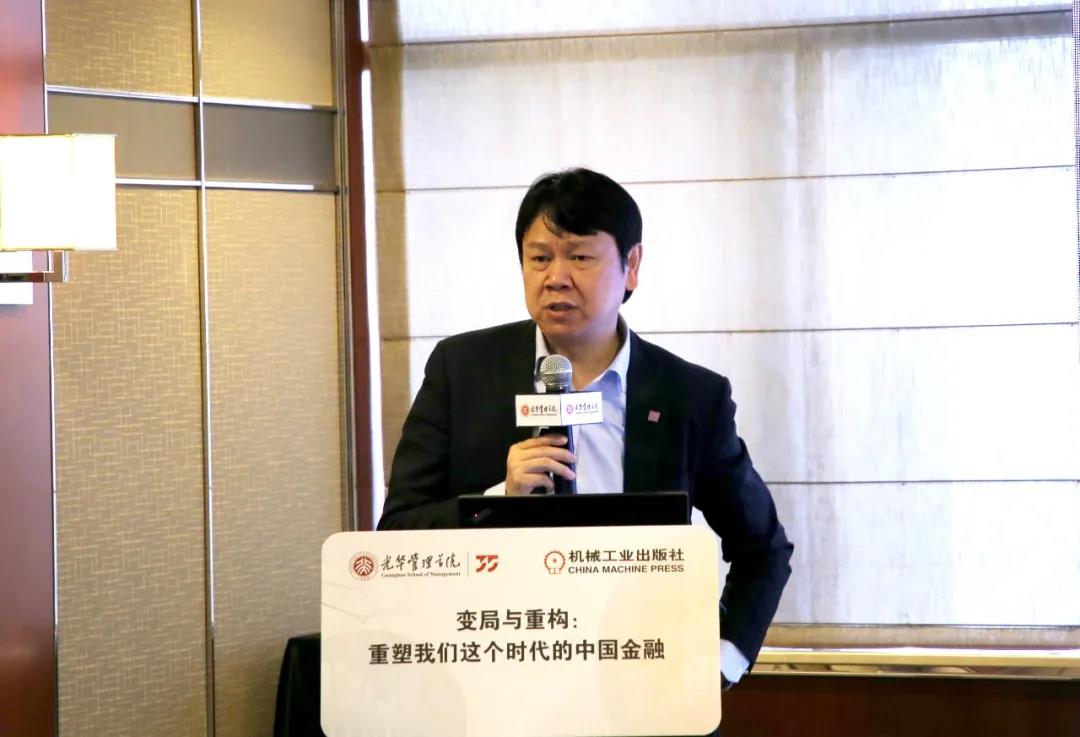Liu Qiao: How to rebuild China’s finance
Sep 09, 2020
Peking University, September 9, 2020: China’s financial system has its own evolutionary logic, breaking points and issues that need addressing urgently. In his new book The Finance We Love published by China Machine Press, Professor Liu Qiao dwells deep into the country’s current financial state and explore how to ensure its quality development.
The following are excerpts from a speech made by Liu, finance professor and dean of Peking University’s Guanghua School of Management, earlier this month at an event for the book.
Basic Model of Finance
What is finance? It is, in essence, an intermediary that links the supply of funds and demand.
China has been using the market as a key method to allocate resources since 1978 when the reform and opening-up kicked off, paving way for the prosperous development of various financial formats. As the country is transitioning from a focus on speed to high quality development, its finance must adapt to such quality development and help boost it.
Those considering finance as just a tool that converts deposit to investment only have the simplest idea. Finance is really much more than that.
In modern economy, finance is a complex eco-system consisting of five modules: the real economy, the financial system,government’s macroeconomic policy, international circulation of funds and the pricing of assets.
If something is wrong with any one of these modules, risks will accumulate and,in severe cases, financial crises will emerge.
Seen from this angle, it will be clear how we can reduce risks, avoid crises and draft policies in a given phase of economic development and a certain growth mode.
In order to prevent systemic financial risks, we can adopt a concept of good finance and bad finance.
Academically put, good finance is one where the cost of an intermediary is kept to a minimum. In other words, good finance should be able to prevent and resolve risks and continue to serve the real economy well.
Based on this theory, when things go wrong with one or more modules, the normal process of the financial system injecting credits into the real economy will be disrupted, leading to bad finance.
In order to build good finance, efforts must be made to strengthen ties between the financial system and the real economy and safeguard a solid balance among the five modules.
Puzzle of Financial Development
In the United States, two cents are needed to produce financial assets worth one dollar. This equation kept fluctuating slightly over the past 130 years but never strayed too far. Both Germany and France have a similar level. In other words, the cost of financial assets has been maintained at around 2 percent.
This phenomenon is perplexing since humans are supposed to get more clever and financial development should serve the real economy increasingly better. Instead, finance is progressing but the cost of the intermediary does not drop — we call this “the puzzle of financial development,” a universal conundrum that is key in our understanding of many financial problems.
When we look at the changes in China’s financial system in the past 70 years, the ratio of financial assets to GDP is a key dimension. This ratio was 0.5 in 2004 but soared to nearly 3.9 in 2018 with financial assets reaching 350 trillion yuan (50.6 trillion U.S. dollars) and GDP 90 trillion yuan. For an economy that officially embraced the market only in 1978, this progress is staggering, closing in on the 4.5 in the U.S.
China’s financial industry value added is 7.7 percent of GDP. In comparison, the figure is 7.5 percent in the U.S. In terms of contributions to the economic growth,China’s finance has been catching up at a stunning speed over the past 40 years, with many indices surpassing those of the U.S. and other developed countries. That said, how much does it cost for us to produce one dollar?
According to estimates based on the average cost for a commercial bank to produce a loan worth one dollar, the answer is about 3 percent. However, for smaller banks that mostly loan to micro, small and medium-sized businesses, the figure reached as high as 8 and 9 percent in 2014 and 2015.
Simply put, China’s finance has reached a considerable scale, but the cost of the intermediary has not dropped. Here, the puzzle of financial development is even more urgent. How to reduce this cost? This is the key question for China’s finance. Our target is not more, but better finance. How to achieve good finance in China? The answer is lower the cost.
Leverage & Bubble
Catchphrases like “deleveraging” in 2017 and “stabilize leverage” in 2018 are crucial for people’s understanding of China’s monetary policy. However, without supply-side reform, it will be very hard to achieve deleveraging.
Why? China’s financial growth is credit-driven, and credit plays a decisive role in GDP growth a year later. In other words, more money means faster GDP growth, and credit and GDP are closely correlated. This is commonly agreed and verified by real-world data.
In the past 40 years, constant investment is the reason for fast monetary growth. Since 2010, the growth of the M2, a broad measure of money supply that covers cash in circulation and all deposits, is 6.1 percentage points higher than GDP growth every year. Even when we cut three percentage points from prices, the growth gap is still 3.1 percentage points higher.
Here is the question: where has all the money gone when there has been no inflation?
In China, huge investments in land and property following land auctions have accelerated the monetization of land and property. In other words, China’s economic growth is mainly driven by monetary finance based on soaring bank credits. The reason for huge money supply and no inflation is that infrastructure such as land and property being mortgaged has accelerated the monetization and capitalization of China’s economy all these years.
The value of housing properties in stock, according to some estimates, is nearly 300 trillion yuan.
However, when the economy switches gear and growth slows, it will be troublesome to maintain such a high money supply rate. We need to think about financial development in the future and re-evaluate the path and model of our financial expansion over the past 40 years.
So what’s the biggest problem for China’s economic development right now? My answer: leverage ratio!
The macro leverage ratio is the percentage of total debt to GDP. China and the U.S. are at the level of 2.6 to 2.7. France is roughly 3.5, Japan hitting 4.
However, in China nonfinancial debt alone is 1.5 to 1.6 times its GDP. With the average interest rate on loans to companies estimated at 6.3 to 6.4 percent, interests paid by Chinese firms for their loans amount to 10 percent of GDP. This is an unhealthy financial system. How to lower sky-high corporate debt?
First, we need to consider why debt for Chinese firms is so high. The answer is low investment efficiency as a result of weak economic microfoundations and wrongful allocation of financial resources.
For listed companies, the average return on invested capital (ROIC) is only 3 percent. In other words, a listed firm can only earn three cents as after-tax profit one year after one dollar is invested in the financial system.
It is not uncommon to expect 6,8 or even 10 percent return when it comes to stocks and various wealth management products. Listed firms have to borrow more and increase leverage to compete. It shows that the real economy is already lagging behind investors’ expectations. Forced by the situation, entrepreneurs go to every length to borrow money,pushing nonfinancial debt higher and higher.
In terms of the allocation of financial resources, those with high ROIC usually have a hard time getting funds while those with low investment return have their pockets full. Among listed firms, ROIC for privately-owned companies is shy of 4 percent while the figure for state-owned enterprises is only 2 percent. Meanwhile, only 14 percent of new loans in the country went to privately-owned businesses in 2018. By the end of 2018, balance of loans for these companies only took up 25.8 percent of the total balance of loans in RMB. It is a distinct symptom of inefficient resource allocation that those capable of really boosting quality economic growth are starved of funds. Left unaddressed, these bubbles will only grow bigger.
Is there a one-size-fits-all method for deleveraging? Or, is there good leverage and bad leverage? If there is, how can we tell? My answer: good leverage should be able to boost a country’s total factor productivity (TFP), while bad leverage increases bills and saps a country’s will for repayment. In other words, deleveraging policies should differ depending on different leverages.
Origin of Bad Finance
What leads to high leverage?
One of the biggest problem in China’s financial system is the absence of a pricing anchor for the market and the function of price discovery that can guide effective resource allocation.
People usually buy low and sell high, and there is a hedging mechanism. The pricing mechanism guides the society in resource allocation. If the price does not reflect an item’s true value (say, something worth 100,000 yuan priced at 30,000 yuan), the supply-demand relationship will be distorted and resource allocation becomes dysfunctional, which will lead to a series of problems.
This is where our biggest problem kicks in — the absence of an anchor for risk-based pricing. Money gathers where it is not needed, and those in demand of funds are starved. It is the same everywhere — be it capital market, credit market, real estate market or infrastructure financing and investment market.
Let’s first look at the stock market. The outcome we get when subtracting the overall return of a stock market from the risk-adjusted return of national bonds is usually positive. This result can measure the risk level of a country’s stock market — higher risk premium points to higher risks. The figure for the U.S. in the past was 6 percent. Meanwhile, China reported 1.2 percent and then the figure lowered to zero in the past decade,which means China’s stock market and bond market are equally safe.
Some people think the science and technology innovation board, also known as the STAR market, can solve this problem. Unfortunately, without the anchor of pricing, it is unlikely. Some still believe the government will step in to do the rescue after all. If we cannot change our mindset about risks, the function of pricing will remain absent in the capital market.
Let’s compare the values of China’s ChiNext and Nasdaq, two similar stock markets that focus on hi-tech, high-growth firms. Nasdaq boasts a stringent delisting mechanism. In Jan. 2018, it had 2,527 firms, among which more than 2,500 submitted their full trade data. Their price-to-earning (PE) ratio then was 35.8. Meanwhile, ChiNext had 716 firms, and their PE ratio was 48.1. However, when we only consider listed firms with a market value of 10 billion yuan or lower, Nasdaq had 2,338 such firms with a PE ratio of 208 (a huge increase) while ChiNext had 605 such firms with a PE ratio was 51.3 (only slightly higher).
Usually a firm with a smaller market value enjoys better growth, but this is not reflected in ChiNext. It shows that our market lacks the ability to gauge growth potential. In other words, this market is distorted.
As a result from this distortion,balance from direct financing in 2018 amounted to 12.36 trillion yuan while new loans from banks hit 15.7 trillion yuan — the outcome of our capital market’s financing for nearly 20 years did not even compare to the amount of loans granted by banks in a single year. Inadequate direct financing capacity has been dragging down China’s economic development and the innovation of the real economy,and the reason behind this is none other than the absence of risk-based pricing.
Now switch our focus to the local government. What is the proper interest rate for bonds issued by local governments? In an effective market, this rate is inevitably pegged to risks. However, some local governments set the rate at 0.2 percentage point lower than that of national bonds. Does it make sense that local government bonds carry less risks than national bonds? How to explain this paradox besides price distortion? When a market’s resource allocation rules are violated, no explanation will be satisfactory.
High leverage and chaos in the financial system ultimately originate from the absence of risk-based pricing.
Breaking Points
An X-ray of China’s current economic state based on the five-module theory will find ten breaking points that might lead to the aggregation of systemic risks, and we should take precautions against them. Effective measures such as supply-side structural reform will help address these weaknesses.
First and foremost is very low return on invested capital in the real economy.
Second is unequal distribution of income. How does income inequality affect a financial crisis? Just look at history. The U.S. suffered the Great Depression at its peak of income inequality around the 1930s. Another peak came in 2007 and 2008. The medium and high income groups pour plenty of funds into the financial market and real estate, leading to huge amounts of bubbles in the capital market. The economy suffers when these bubbles burst.
Then there is the aging population that merits particular attention. Some believe that with China’s high savings rate of nearly 50 percent, even a low-efficiency financial system will still be able to generate a lot of investments on fixed assets such as the upgrading of old town areas. However, the country’s population is growing old at such an incredible speed that, according to the estimates of Guanghua’s research teams, there will be one aged 65 or older in every four Chinese by 2035, and there will be severe consequences. A rapidly aging population will lead to lower savings rate. This will,in turn, cause profound changes to our spending structures and shake multiple industries. The investment-driven growth mode will also be disrupted.
Non-optimal urban population distribution is the fourth point. According to Guanghua’s research, about 88 percent of China’s smaller cities are severely underpopulated — their current populations are only 40 percent of the amount deemed most economically beneficial. As a result, the service sector will have a hard time taking off, and emerging industries will remain absent in these cities. More importantly, many investment projects in local real estate, infrastructure and public service will be invalid since there are not enough people to make these investments effective in the first place. For these cities, the usual logic of economic growth is just not applicable.
High leverage and ensuing excessive development, firms’weakened balance sheets, and inefficient allocation of financial resources are another three breaking points. Burdened by huge debt, firms will have a hard time doing research and development, making investments and paying off the debt. How will this affect China’s real economy and what kinds of dynamic changes will it cause? These are among the structural problems we need to focus on and find resolutions for.
Eighth is moral hazard of financial institutions under financial constraints. Many people made a lot of money by using shadow banks to stretch their financial business chains long and obscure. Then new asset management rules came and ruined their party. Financial institutions should consider how to lower intermediary cost. The evolution of a financial system also abides Darwinist rules. Failure to actively lower intermediary cost will lead to extinction. It’s the survival of the fittest!
Ninth is the absence of the anchor of pricing. The last one is the constantly weakening marginal effect of macroeconomic policies.
Now is the time to ponder all these issues. What kind of finance do we need? What kind of finance do we love? How can we better take up the many challenges and seize the many opportunities? How do we build a structure for the future? If we can figure out effective measures to address all the ten aspects, we will find the kind of finance we love in 2035.
Clear goals are needed in order to rebuild China’s finance. A crucial one for the supply-side structural reform is to boost intermediary efficiency and lower cost. That is the only way finance can retain its vitality as an intermediary.
There are several approaches worth recommending:
— change our mindset for development and economic growth mode, rebuild economic microfoundations.
— reform government functions, eliminate ownership-based discrimination, uphold the principle of competitive neutrality: growth will mainly come from enhanced TFP, and TFP growth will be closely linked to innovation and entrepreneurship; the government should intervene less in economic activities and allow the market to play the decisive role in resource allocation.
— equip financial assets with a pricing anchor and fully realize the market-based distribution of funds.
— push forward the market-based reform of labor force and land distribution.
— find a pricing anchor for land, property and infrastructure with the help of REITs.
— other measures of financial supply-side reform.
All these combined will hopefully help us find a way to reduce the ever high intermediary cost in our financial evolution.
Happily, some of these are already happening. The introduction of registration-based IPO system in ChiNext and a pilot scheme for REITs are two landmark events in China’s capital market this year. Once these two moves are in full swing, 2020 will prove a fruitful year for the country’s capital market. History will show that this is also the correct path.
Source: PKU Guanghua School of Management



